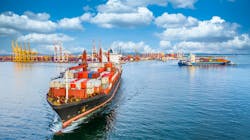What Do Ongoing Shipping Disruptions Tell Us About the Future of Supply Chains?
From a ship stuck in the Suez Canal, to piracy, to a worldwide shutdown, there’s no question that the supply chain has seen its fair share of chaos in the last five years. This is especially the case for ocean shipping.
Most recently, maritime transport has been hindered by vessel attacks in the Red Sea off the coast of Yemen. The Suez Canal, which connects the Mediterranean Sea to the Red Sea, is a crucial waterway in this region; the canal handled approximately 12% to 15% of global trade last year, according to United Nations Conference on Trade and Development.
In the manufacturing industry, where international trade is a core fundamental, supply chain woes have implications for both companies and consumers.
What’s At Stake?
According to Port Economics, Management and Policy, about 70% of international trade value is carried by maritime transportation means, and two-thirds of this is carried by containers.
Ocean transportation supports global commerce and day-to-day living around the world, but unlike road and rail, which typically tend to be within one region or nation, oceans are more exposed, says Pawan Joshi, EVP of products and strategy at supply chain platform e2open.
“Ocean tends to be the cheapest, most carbon-efficient, but it’s also the slowest, and it also relies on a lot of extraneous conditions much more than other modes of transportation,” he says.
Maggie Slowik, global industry director for manufacturing at IFS, reflects on the nature of global commerce. “I don’t really see manufacturing companies to be sort of tied to a specific geography … Somebody asked, ‘What does a Belgian manufacturing company look like?’ There is no such thing, right? Because of their supply chains being so spread out,” she says.
With our world continuing to optimize the time and cost effectiveness of trade, manufacturers have found themselves in an extremely connected environment. This growing interdependence has bolstered the need for reliable, efficient transport.
“Our world over the last 30, 40, 50, 100 years, if you want to go all the way back, has always relied on global commerce, and it’s become even more reliant on global commerce,” says Joshi. “Manufacturing and production of goods has increased quite a bit, and the cost of producing anything and bringing it to market has gone down.”
The Big 4
There are four major choke points in ocean shipping:
- The Suez Canal
- The Panama Canal
- The Strait of Malacca
- The ports of Amsterdam and Rotterdam
Two of these points have been especially pronounced in recent years.
The drought in Panama has created numerous issues for the waterway, including tonnage restrictions, a reduction in booking slots and extended wait times. Attacks on ships in the Red Sea have left companies scrambling to adjust their trade routes and strategies.
“Both the Panama Canal and the situation in the Red Sea have forced the redefinition of a lot of sea lanes. Rather than going through the shorter distance and crossing it, you have to take alternative means,” Joshi says, mentioning tactics like moving freight over land and taking longer routes.
Will the Chaos Ever End?
Since the pandemic, supply chain issues for companies have been a constant, says Slowik. “They can’t get up; they can’t get a rest. Now the next crisis is in … Companies are having to attune to a whole new reality, one that is really marked by this notion of accelerated disruption.”
Joshi calls the pandemic a “wake up call” for brands and nations. Climate change causing unpredictable weather events and rising geopolitical tensions “are non-supply chain events that absolutely affect supply chains across the board,” Joshi says.
As extreme events become more frequent, it is crucial to implement strategies and plan for unexpected constraints in this new reality where situations change at the drop of a hat.
How Can I Manage the Chaos?
Companies must constantly validate and fine tune supply chain operations, Joshi says.
“These disruptions will always happen. They've always happened in the past; they'll always happen in the future. The challenge is we don't know when they're going to happen … The key here is to build that infrastructure, to be very proactive in terms of understanding quickly where the disruption is coming from, understanding the implications of that disruption and then pivoting it around and converting them into opportunities,” he says.
Diversifying suppliers can give companies some flexibility. Another approach is nearshoring; shortening your supply chain will not only comply with new ESG regulations, but provide more control and stability, explains Joshi.
Global Supply Chains Aren’t Going Away
Despite efforts to shorten supply chains, commerce will continue to rely on global connections. As a timely example, Joshi describes how multiple nations are currently deploying efforts to stabilize conditions in the Red Sea.
Some raw materials and food products can only be found in certain parts of the world, he says. “At the end of the day, the true constraints in the supply chain are not me and my production facility, it is me, my production facility and four or five tiers upstream that go all the way down to that critical component or ingredient,” he says.
About the Author
Anna Smith
News Editor
News Editor
LinkedIn: https://www.linkedin.com/in/anna-m-smith/
Bio: Anna Smith joined IndustryWeek in 2021. She handles IW’s daily newsletters and breaking news of interest to the manufacturing industry. Anna was previously an editorial assistant at New Equipment Digest, Material Handling & Logistics and other publications.


